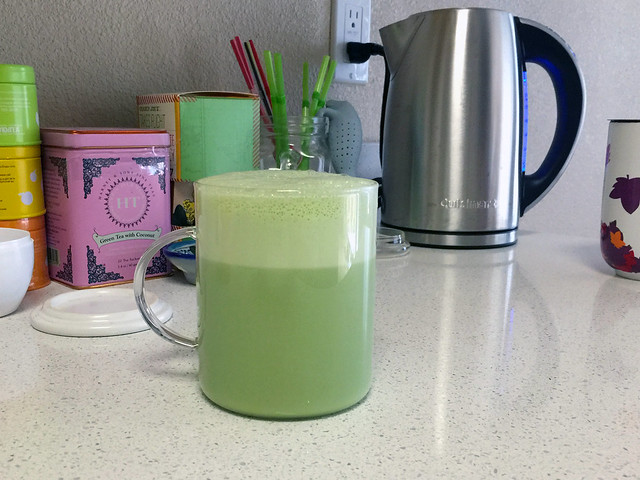I had my first matcha tea many years ago and it’s always something that I order when we go to Japantown or other tea shops that serve it, but I never tried making it at home because it seemed to require a lot of technique and equipment.
Last year I got a Vitamix for my birthday and started experimenting with a lot of smoothie recipes. One of my favorites became a green smoothie with spinach (or kale), mango, pineapple, and a teaspoon of matcha powder.
Those matcha smoothies led me to wonder if I could make traditional matcha in my Vitamix, eliminating the need for specialized equipment — a sifter, a whisk, and a matcha bowl — and cutting down on the time it would take to whisk matcha to the perfect consistency.
One of the nice things about a Vitamix is that it can handle hot liquids because there are vents in the lid. This is not true of all blenders, so you may not want to mix hot matcha in a standard blender.
Making matcha is as simple as heating up a cup of water (I heat eight ounces in an electric kettle and I like it best at 175°F), pouring it into the Vitamix container, adding the matcha (I do a teaspoonful because I prefer my matcha thinner), putting the lid on, and turning it on. Start out at the lowest setting and crank it up from there — it doesn’t need to blend for more than a few minutes. You don’t need to sift it because the Vitamix isn’t going to leave any clumps.
This method results in a cup of matcha that tastes similarly to whisked matcha. The powder dissolves completely and blends in (there’s no separation) and it produces a lot of matcha foam, which is what you want. Make sure to open the Vitamix up carefully, because this does create a lot of steam. You’re also going to want to make sure you’re only blending a few cups. Don’t fill your Vitamix container all the way up with hot liquid.
With a whisk you can make thicker or thinner matcha depending on the powder to water ratio and the type of matcha being used, and the same is true with the Vitamix. You’re going to get more froth with koicha (thick matcha) than you would with a whisk in the Vitamix, so it may not be the best way to make this type of matcha if you want a traditional texture.
You can also use the Vitamix to do matcha lattes with almond or soy milk. You can make lattes in one of two ways — heat the milk before you put it in the Vitamix, or use the Vitamix to heat the latte. With the former method, add milk, matcha, and sweetener if desired and mix for a minute or two on the highest setting to get lots of foam.
Heating the latte in the Vitamix itself will take a bit longer. Use the highest setting on the Vitamix and leave it on for approximately six minutes or until you get the desired temperature. If you’re not familiar with the Vitamix, the speed at which the blades rotate allow it to heat up liquids.
Matcha lattes mixed in the Vitamix come out smooth and creamy, with lots of airy matcha-flavored foam. You can also make a Starbucks-style matcha frappaccino by using a chilled cup of milk, a small bit of honey or agave syrup (if you want it sweetened), a scoop of matcha, and a handful of ice.
I don’t care for regular tea with milk, but matcha and almond milk taste like a pairing akin to peanut butter and jelly. The almond milk cuts down on the bitterness of the matcha and gives it a rich, soft texture.
One last thing to keep in mind: make sure you’re using a high-quality matcha that’s very bright green in color for the best taste. For straight matcha and matcha lattes, you don’t want culinary grade stuff — it’s not going to taste very good. Culinary grade matcha is perfect for smoothies though, because you’re blending multiple flavors and not relying on the taste of the matcha alone.



I never thought to use the vitamix! I’ve been whipping out my Cuisinart immersion blender since it makes clean up soooo easy. I love the idea of incorporating it in a kale smoothie.